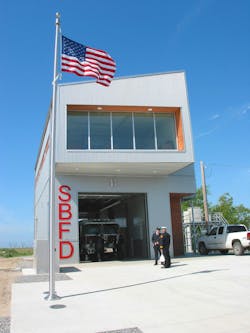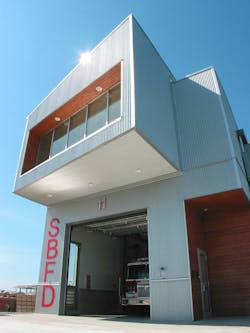In the aftermath of a hurricane, tornado, wildfire, or other disaster that destroys or damages your fire station, how do you prove to a Federal Emergency Management Association (FEMA) Project Manager what your station looked like and contained? What exhaust system and equipment were in the apparatus bay? Appliances, PPE, and tools? Kitchen, living, and sleeping areas? EMT supplies or other items required for response?
“The first step in preparing for a disaster is to document what you have now,” advised John “Jay” Chase, Jr., AIA, Principal, Chase Marshall Architects. “Take pictures of the station before a storm to provide proof of what the station looked like, exterior and interior, and throughout the interior. Have information about the equipment inside saved electronically to the cloud. Trying to explain to a FEMA Project Manager what you had is almost impossible without this information following the devastation of one of these storms.”
Chase explained that after a hurricane, the first step is to stabilize the station and hire a qualified program manager. “FEMA requires a Program Manager for each project. It’s important to hire a program manager who has experience with fire and public safety facilities and knows how to respond in a disaster to a damaged or demolished fire station.”
Disaster response
St. Bernard Parish, a marshy area in southern Louisiana, has had its share of hurricanes. In August 2005, the parish was slammed by Hurricane Katrina, a Category 3 with wind speeds of 140 mph and experienced the worst area damage from the storm. In St. Bernard Parish alone, 163 people died and the fire department rescued more than 6,000 stranded and injured residents.
Firefighters were overwhelmed with demands for emergency medical services, rescues and recoveries. The trauma of losing their 10 fire stations, coupled with the heartbreaking concern for their own families and property losses resulted in mental and physical issues for the responders.
After the storm, St. Bernard’s population dropped from around 67,000 to 35,900 by 2010. Chief Stone and his department were determined to build stronger, more durable new fire stations. Working with Jay Chase, new stations were developed to withstand 15-foot flooding conditions.
Chase Marshall Architects was the architectural firm working with St. Bernard Parish Fire Chief Thomas Stone to rebuild their 10 fire stations in the aftermath of Hurricane Katrina.
Among the new stations, St. Bernard’s Fire Station No. 6 had two apparatus bays and living and sleeping quarters for four firefighters. During the planning phase, Chase Marshall and parish officials determined fire stations should be two stories due to the complete devastation left by Hurricane Katrina. By placing the private functions of the stations on the second level, the fire department is properly staged to operate during future rescue and recovery efforts.
In 2010, St. Bernard Parish Fire Station No. 11 received the “Judges’ Choice” Award in the Fire Chief Magazine’s Station Style Design Award. This fire station included a single apparatus bay and on the second floor, living and sleeping quarters for three firefighters. The station was designed with high-performance, metal breakout panels to help mitigate potential damage from future hurricanes.
Hurricane Ida
While location is everything, historically Louisiana is prone to hurricanes and in August 2021, Lafourche Parish was slammed by Category 4 Hurricane Ida. According to Jay Chase, several of their fire stations were destroyed. This time, among the fire stations damaged, three fire stations were able to be renovated because they had sustained less than 50 percent damage, the threshold for demolition.
Whether rebuilding or renovating, FEMA has guidelines to follow, in fact, the cover photo on the FEMA book is a St. Bernard Parish fire station and the guidelines are the same ones developed by Chase Marshall and Chief Stone. Jay Chase also cautioned that besides trying to comply with FEMA requirements, ADA can pose challenges, especially in building a two-story fire station to withstand hurricane-force winds.
“In designs for St. Bernard Parish fire department, we have no occupiable spaces at grade,” Chase explained. “Fire departments have operational plans to move vehicles to elevated areas. Everything we build, you could take a fire hose and wash it out on the first level.”
Hurricanes, tornados, or other major disasters will continue, and first responders will continue to respond to calls for help even without a fire station.
“A fire station never rests! It is a 24 hours a day, 7 days a week building,” the architect added. “And my job is to protect human life too.”







